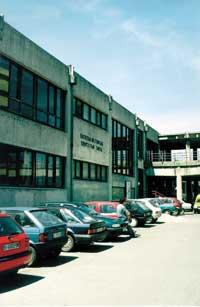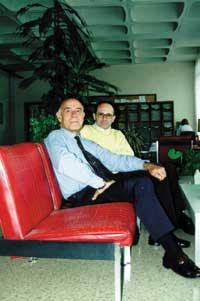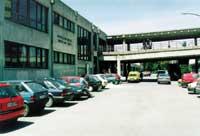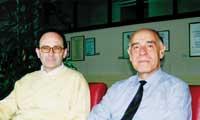First promotions of the Faculty of Sciences
How much things change

The construction of the Faculty of Sciences is now in Leioa, but has not existed since its foundation. 30 years ago, with the constitution of the University of the Basque Country, the steps of the young people who chose scientific studies were headed elsewhere. In fact, the provisional building of the Faculty of Sciences was installed in Bilbao, at the Nautical School located opposite the University of Deusto. Before its transfer to Leioa, the Faculty of Sciences had a new headquarters, a pavilion built next to the old building of the Nautical School. Jaxinto himself took the second and third courses.
The students of the first promotion went to Leioa for the fourth year, but not to the current building of the Faculty of Sciences. It had not yet been completed and had been incorporated into the Faculty of Medicine. The last year of the studies did pass the first promotion at the new headquarters. Thus, during five courses the first group of graduates who left the Faculty of Sciences of Leila had four different venues. “Then getting to Leioa was also an adventure. Were there no serious roads to be, most people walked on the ‘auto-stop’… buses? Yes, they existed, but as we came very few and many people came here it was difficult to catch us”.
As you can see, Jaxinto remembers well those early years. “At first we were about 160 people, divided into four groups, but we were not all new. In fact, some came at the end of high school, but others studied chemistry, since before 1968 the Jesuits taught chemistry in Deusto. Those students went to Zaragoza to take the exams. After the creation of the public university, the chemistry studies of the Jesuits disappeared. Those who studied chemistry in Deusto entered the public university, in our faculty.
In addition to the Chemistry studies of Deusto, at that time the only place to conduct technical studies in Bilbao was the School of Engineers and Technicians. What until then wanted to do scientific-technical things, or if he was going to go abroad or he was going to be an engineer, so he went from there to do chemistry or physics to the public university.”

Euskera and science, like many other things, emerged from the beginning of the newly created university. “The first year Basque classes were organized. After sending the association Euskarazaleak de Bilbao to the professors of the Faculty of Sciences and Medicine who came a professor to teach Basque, two groups were organized. Doing something like this had merit at the time, but a couple of years later it went off due to schedule problems. The engine was later the EU, with dozens of books. With the EU, Basque university production begins, develops and continues. The EU has given great impetus to the Faculty of Sciences and to many professors here as well to the EU.”
Despite being less crowded, Jaxinto felt that things were not easier than now, than the need to move through buildings, the problems of adaptation of laboratories, the difficulties of access to the Faculty itself... did not make things easier for them. “Since we started, taking into account all the degrees, at 50 we would not have finished the studies, one in four. A demanding faculty? good, safe and who is asked. Those who test it will not seem like that, but others will surely.”
As time does not go unnoticed, it is clear that since the first group of graduates who left Leioa finished their studies there have been major changes in many fields, including the Faculty of Sciences of Leioa. “The difference is huge. We have also changed, of course, the students who come are different or at least we see them like that, that is, the youth of then has nothing to do with the current one.
Some of the responsibilities will be similar to the current ones, but society has changed and the Faculty has joined the society. The teachers have changed, the environment has changed… then the restlessness was for some reasons and what there is today is for others, but if there is concern. The famous 68, the Burgos process… everything was reflected in the Faculty and there are problems that we all know today and that are also reflected.
If we look at the academic field, perhaps in our time it should be said that the previous training was better, that is, that at present we had more base than those that come from the baccalaureate. But this situation is not exclusive to the Faculty of Sciences, it is much more general.
As for the relationships between teachers and students, as a member of the first promotion, I can say that most of the teachers were very young, recently completed theses, recently incorporated into the teaching... then we had quite close to the teachers, and in that sense there were no leaps of age or “respect”, and in that sense I would say that we had relationships, not narrow, but close.
Currently, there is quite good relationship with teachers in general, teachers are quite close to the problems of students. On the part of the teaching staff there is a desire to debate, learn and mentor with the students, in this sense well. On the other hand, there is a problem of massification, too many students per teacher and the attention is not what the student wants and there is difference”.
Since the Faculty of Sciences of Leioa is the Faculty of Research Sciences, we must also talk about research, with desire and desire, because since that first promotion came out things have changed a lot in the fourth century. “If we compare it with other countries where the investigation is carried out, we should say that we are behind us, that we live in poverty. However, if the comparison was made with what we have had in the past, we must clearly say that we have advanced. Undoubtedly, we have made a lot of progress, especially for the work we have offered.

We always say that to get the fruit here we have had to do a double job, do research and get research means, for lack of structure and staff. Teachers here, in addition to educational work, have to perform technical and administrative tasks. With all these works, today we are well, taking into account the means we have had. In general, I would say that the research of the Faculty is quite good.”
Joseba and Jaxinto have mentioned the infrastructure problems, transferring to these lines the work they have had to do to get the infrastructure. The headquarters itself must be included in this group. Despite the fact that for a building there are not many 30 years, the building that Jaxinto and his companions first stepped on around the fourth century has become obsolete. “When this was done it became too fast and with little budget. It started in 1968 and ended in 1972, but it was too big and badly designed. However, in the last 25 years we have had to live there, but there are many people. The building was thought for 1,500 people and at this time there are about 6,000 people daily, and with capacity for 150/200 teachers at this time we will be 400. We need a new building.”
The past, the current situation… and if it has had a reflection in society that has to do with these two concepts, the influence of the faculty. “30 years ago the University of Deusto, Sarriko and the School of Engineers were the branch of university education in Bilbao. Since 1968 social influence has been enormous, although then it is not clear what it was for.
The Faculty of Medicine is clear that it was to create doctors, but what is needed for the Faculty of Science? What are physicists and mathematicians needed for? Then they wondered things like that. Subsequently, it has been seen that the presence of graduates in society has been a success. It was a bet at the time, a minority believed in it and today it is rooted in society. Physicists, mathematicians, chemists, geologists and biologists who leave here have great strength in today’s society.”
During this time, both Joseba and Jaxinto have worked as mere teachers, but they have also held positions. They emphasize the difference between working on one job or another. “They cannot be compared, they are different. As a teacher he relates more to people, students, etc. Instead, as deans or rectors they command responsibilities. The teaching work is more complete, but often you have to take things as they come.”
From the superficial point of view, and beginning to talk about the positions, when talking about the history of a Faculty, we cannot forget the matters of hierarchy so rooted in the University. “When the faculty arose there was only one or two professors who had all the strength that the university law gave them. Over time progress has been made, laws have been modified, things have been simplified and the road is wider, there are more professors. Now, if someone works with the philosophy of 25 years ago, thinking that he is God, look aside and see other professors and cannot feel God. That hierarchical structure is there, but that hierarchy has undergone profound changes.”

Social differences, faculty, building… since the first promotion came out. They have also changed those of the first promotion over time. In their relationships, not so much. “If I have a relationship with those of promotion, not so much, but yes, sometimes we are, and now, on the occasion of the celebrations, we have had more chances of being together. With alumni? The truth is that I don't remember all the students who have had, those who come to class, of course. Apparently I come to read some name and it comes to mind, I have had this student, but I find it difficult to find the face and the name. Over the course of these 23 years I have had an average of about 40 students per year, some on more than one occasion, not liked, but I do eat.
Has the Faculty improved? On the way we go well, in research, in teaching and in personal relationships. There have also been bad times. The hardest thing, if possible, is that with five degrees there was a debate to divide the Faculty and create five faculties. It was not done and it was finished. They were bad moments of development.”
Related informationBilbaíno. He finished his baccalaureate in the founding year of the University of the Basque Country. In 1968 he entered the new Faculty and completed his studies in 1973. Therefore the first promotion. After remaining in military service he performed a test and returned to Leioa as assistant professor. He spent two years researching in the United States and has since been in Leioa. From 1986 to 1990 he was Vice-rector of the Basque Country. Related informationArenal. He studied in Zaragoza, where he did the thesis and began to teach. He came to the University of the Basque Country to work at the Faculty of Sciences. For several years he was dean and vice-rector. He is physical and 58 years old. |
Buletina
Bidali zure helbide elektronikoa eta jaso asteroko buletina zure sarrera-ontzian











